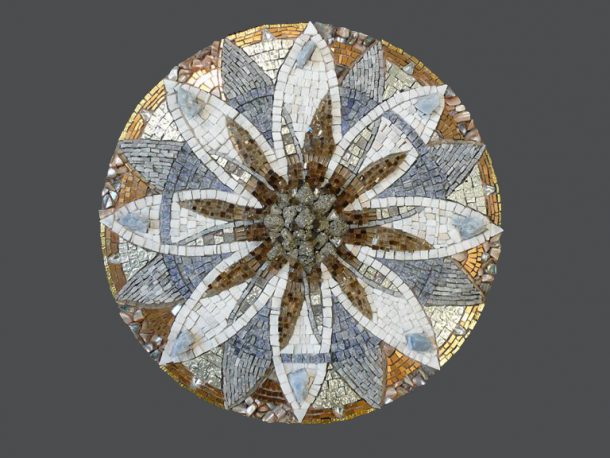There is a major buzz happening right now. The world of ancient mosaics is bubbling up for our consideration. Recent significant discoveries have been unearthed all over the former Roman Empire, from the UK to Turkey, to Sicily and Israel. It’s proving that digging for a new parking lot could take just a teensy bit more time than planned.
A meeting of ancient futures has arrived.
Consider this pair of images:

The similarities are uncanny. Mysterious eyes. An iconic expression of troubled times: Then and Now. Are recent excavations and discoveries of ancient mosaics pointing us toward attentiveness? Are the stories discovered in the ancient mosaics a “second chance” to learn from our past? Why the recent increase in popularity and worldwide interest in mosaics?

1983 Afghan Girl,Steve McCurry
Steve McCurry made the picture of the Afghan girl in 1983. No doubt this is one of the most memorable pictures in National Geographic’s history. He could not have been influenced by the Zeugma mosaic, because it was not excavated until 1992.

1992 Zeugma Mosaic- Photo: © Aliza Ri
The conservation of ancient mosaics is an expensive, time consuming, political, and often contested subject. But the fruits of this labor gives us unprecedented insight into our timeless connections through an architectural— no, archetypal—form of storytelling. They provide a way of thinking in terms of relationships, patterns, and context. That kind of holistic perspective is crucial to our future survival on the planet. These two images make us feel something. They collide in time, but we see an iconic emotion in the eyes of these women. The mosaic is thought to be GAIA, Mother Nature herself. The McCurry image by the same token, struck a cord with our deep emotions to become one of THE most popular images ever made in photographic history.
The images are so poignant that Icon Painter, Robert Lentz, OFM, a Franciscan friar stationed in Houston, TX was so inspired by the McCurry image, as to base his depiction of Mary Magdalene on the Afghan girl. His work is known around the world and reflects his experience among the poor in this country and in the Third World.

Robert Lentz image courtesy Grace Cathedral, SF
A well-funded conservation effort currently touring the US, is the 1996 discovery of a massive mosaic floor from Lod, Israel. Known as the Lod Mosaic, three of the best-preserved panels have been selected for a loan exhibition. With it’s debut at the Metropolitan Museum of Art in New York, the pieces will travel to San Francisco, Chicago and Columbus, Ohio, before heading back to a brand spanking new “in situ” crib in Israel.

Lod Marine Panel, © Israel Antiquities Authority
By now, maybe you are thinking mosaics are nerdy (and kind of scary), but here are some photos from my current class in session, called Ancient Meets Modern where Intrepid Students dare to take on the wonders of stone for 8 weeks…Ha! take that!
All hail the mosaicisiti, o’ tesselarii and musivarii, o’ archeologists, sages of dust and detail. We Thank You!


I believe the way the world has been changing with industrialization; it is now that more of these intricate ancient artforms are resurfacing from the ground, after thousand of years buried. And it is now that conservators and preservators are giving them the importance they deserve. Also, I can’t wait for the exhibition of the Lod Mosaics in SF. Tha’ts another debate, should these mosaics be removed from the ground or should they be restored, conserved and preserved in their original setting? Thanks Lillian!